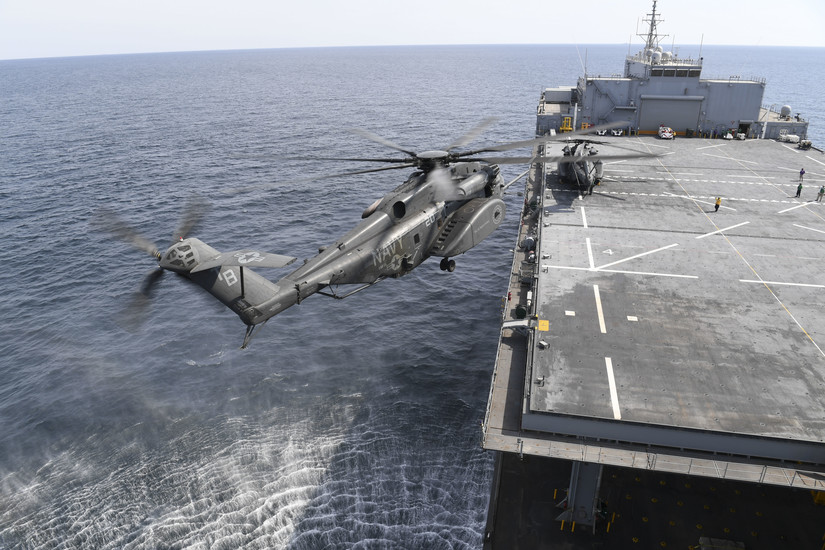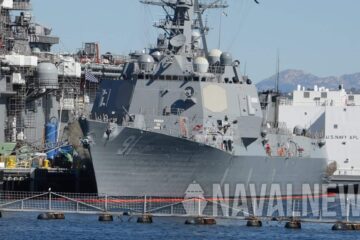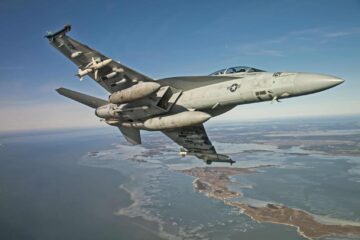The operations, which are designed to enhance the capabilities of U.S. forces to respond to surface threats, have involved Puller performing as a landing base platform for the Apaches, while Cyclone class Patrol Coastal (PC) ships select simulated targets for them to engage. The guided-missile destroyer USS Paul Hamilton (DDG 60) also participated in the joint operations.
“The integration of U.S. Army air weapons teams with other joint fires into the maritime environment greatly enhances our ability to expand reconnaissance and attack capability. The Apaches, in coordination with our surface ships, allow us to hold an adversary at high risk at extended ranges. Combined with other joint fires, these aircraft significantly increase the precision lethality of our joint maritime forces.”
Capt. Peter Mirisola, Commander, Destroyer Squadron (DESRON) 50/Commander, Combined Task Force (CTF) 55
The Apache AH-64E is a twin-engine, four bladed, multi-mission attack helicopter designed as a highly stable aerial weapons-delivery platform. It is capable of destroying an array of mobile armored targets on land and sea using a 30mm automatic gun, aerial rockets and AGM-114 Hellfire missiles.

Similar integration operations with Special Operations assets were conducted in the Arabian Gulf between U.S. naval forces and MH-6M Little Bird helicopters during Operation Earnest Will from 1987 to 1988.

More recently, USNAVCENT surface forces also conducted joint naval and air integration operations with AC-130W Stinger II gunships, assigned to U.S. Special Operations Command Central (USSOCCENT), March 8 and 9.
“Working with USARCENT forces represents another key capability in our ongoing integration of naval and air assets across our joint and coalition force to ensure maritime superiority. This kind of cross-domain integration allows us to maintain highly lethal and effective defensive capabilities, regardless of what platforms are operating in theater.”
Vice Adm. Jim Malloy, commander, USNAVCENT/U.S. 5th Fleet
About Expeditionary Sea Base – ESB

Built by General Dynamics NASSCO, the Montford Point-class is comprised of five ships across two variants: expeditionary transfer dock and expeditionary sea base. USNS Montford Point (T-ESD 1), USNS John Glenn (T-ESD 2), USS Lewis B. Puller (ESB 3), and USNS Hershel “Woody” Williams (ESB 4) have been delivered to the fleet. Miguel Keith is the third platform of the ESB variant, and is scheduled to deliver later this year.
The ESD and ESB ships were originally called the Mobile Landing Platform (MLP) and the MLP Afloat Forward Staging Base (AFSB), respectively. In September 2015, the Secretary of the Navy re-designated these hulls to conform to traditional three-letter ship designations.
The design of these ships is based on the Alaska class crude oil carrier, which was built by General Dynamics National Steel and Shipbuilding Company (NASSCO). Leveraging commercial designs ensures design stability and lower development costs.
ESB ships have an aviation hangar and flight deck that include four operating spots capable of landing MV-22 and MH-53E equivalent helicopters, accommodations, work spaces and ordnance storage for an embarked force. The platform will also provide enhanced command and control, communications, computers and intelligence capabilities to support embarked force mission planning and execution. The reconfigurable mission deck area can store embarked force equipment including mine sleds and rigid hull inflatable boats.

The USNS Montford Point (T-ESD 1) and USNS John Glenn (T-ESD 2) are configured with the Core Capability Set (CCS), which consists of a vehicle staging area, vehicle transfer ramp, large mooring fenders and up to three Landing Craft Air Cushion (LCAC) vessel lanes to support its core equipment transfer requirements. With a 9,500 nautical mile range at a sustained speed of 15 knots, these approximately 80,000 tons, 785-foot ships leverage float-on/float-off technology and a reconfigurable mission deck to maximize capability. Additionally, the ships’ size allows for 25,000 square feet of vehicle and equipment stowage space and 380,000 gallons of JP-5 fuel storage.
USS Lewis B. Puller (ESB 3), the first ESB delivered, along with follow ships Hershel “Woody” Williams (ESB 4) and Miguel Keith (ESB 5), are being optimized to support a variety of maritime based missions including Special Operations Force (SOF) and Airborne Mine Counter Measures (AMCM). The ESBs include a four spot flight deck, mission deck and hangar, are designed around four core capabilities: aviation facilities, berthing, equipment staging support, and command and control assets.
Montford Point (T-ESD 1), John Glenn (T-ESD 2), and Hershel “Woody” Williams (T-ESB 4) have all delivered to the U.S. Navy and are operated by Military Sealift Command. In August 2017, upon arrival in the U.S. 5th Fleet Area of Responsibility, ESB 3 was re-designated from USNS and commissioned as a USS. As a commissioned Navy ship, USS Lewis B. Puller (ESB 3) is commanded by a Navy O-6 with a permanently embarked military crew. This re-designation provides combatant commanders greater operational flexibility as to how the platform is employed in accordance with the laws of armed conflict.







3 Comments
Pingback : Why Army Helicopters Are Launching From a Navy Ship | Continental News Show
Pingback : Why Army Helicopters Are Launching From a Navy Ship - Popular Mechanics - Arms Industry Report
Pingback : Video: Naval News Monthly Recap – April 2020 - Naval News